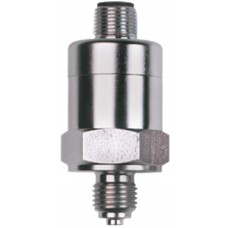JUMO CANtrans p - Pressure Transmitter with CANopen Output (402056)
Features
- Measuring ranges: 0 to 250 mbar up to 0 to 600 bar relative pressure, 0 to 1 bar up to 0 to 25 bar absolute pressure
- Linearized and temperature-compensated measuring range
- Measuring principle: piezoresistive or thin-film (strain gauge)
- Stainless steel measuring cell, fully welded
- Temperature of medium: -40 to +125 °C
- Optional high-temperature version up to 200 °C (SIP and CIP compatible)
- Measured values transmitted in any units to the CANopen bus
- Protection type: IP67
Customer benefits
- Robust to withstand high mechanical loads
Excellent process reliability is guaranteed by the combination of protection type IP67, a high level of vibration resistance, parts in contact with media that are made of stainless steel, and a front flush, welded system.
- Compact and economical
The small dimensions (Ø 27 mm × 65 mm) allow a flexible installation position with simple wiring and assembly, while optimizing use of materials. Uniform parameterization and diagnosis of the entire CAN bus system down to the sensor level results in savings during startup and maintenance.
- Process reliability
Redundant sensors and constant self-diagnosis provide excellent reliability. The data is transmitted from the sensor to the control system quickly and without interference. Additional functions with linearization and scaling, measuring range monitoring, fine adjustment, and the drag indicator function relieve the load on the PLC.
Technical features
- The analog signal of the pressure measuring cell is digitized with a 12-bit resolution.
- The pressure signal is adjusted digitally at the factory.
- The sensor monitoring continuously checks that the sensor signal function is correct and triggers high-priority emergency telegrams in the event of an error.
- The pressure measured value can be scaled to any desired measuring units (or as a percentage of the measuring range).
- The fine adjustment features an auto-zero function and a freely adjustable characteristic line offset.
- Undesired signal fluctuations can be suppressed using the adjustable filter constant.
- The measured value is output with a choice of decimal place.
- The measuring range monitoring has a choice of upper and lower limits. The result is output as a status byte along with the measured value in the PDO telegram.
- The drag indicator function saves the minimum and maximum pressure measured values.
- The date and name of the last maintenance operation can be saved.
- The emergency telegram is triggered in the event of a sensor fault.
- The PDO telegram contains the 32-bit measured value and the 8-bit status. The measured value output can be controlled through various trigger conditions.
- SDO telegrams can be used to set parameters and to request measured values and statuses.
- The heartbeat signal or node guarding can also be used to monitor the transmitter function.
- The sync command can be used to also control measured value transmission.
- The NMT telegrams are used to control the operating status of the transmitter.
- The CAN module ID and the CAN baud rate are set either with LSS or SDO.
Applications
- Wind power units
- Mobile hydraulics
- Boiler engineering
- Medical technology
- Packaging machines
- Plastics processing
- Mobile vehicles and plants
- Rail vehicles
Pressure transmitters are used to record relative and absolute pressures in liquid and gaseous media. The pressure transmitter operates according to the piezoresistive or thin-film strain gauge measuring principle. The pressure measured value is digitized and made available through the "CANopen" serial bus protocol for further processing (CAN slave). A number of additional useful functions are achieved with the DS 404 device profile.
All settings can be made using standard CANopen software tools.
Write a review
Your Name:Your Review: Note: HTML is not translated!
Rating: Bad Good
Enter the code in the box below:


